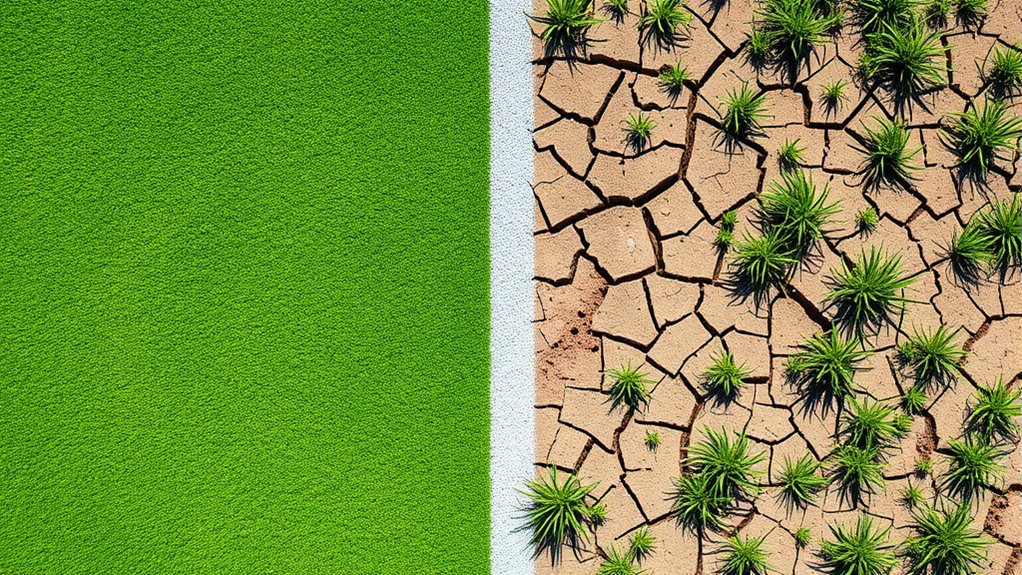Switching from natural turf to synthetic surfaces impacts the environment quite a bit. Synthetic fields are made from plastics derived from fossil fuels, which require energy-intensive manufacturing and release greenhouse gases. They also don’t need water or chemical treatments like fertilizers, but their production, maintenance, and disposal create waste and pollution, often ending up in landfills. If you want to understand how these choices affect the planet and explore eco-friendly options, keep exploring this topic further.
Key Takeaways
- Artificial turfs are made from fossil fuel-derived plastics, which contribute to greenhouse gas emissions and environmental persistence.
- Natural grass requires significant water and chemical treatments, causing resource depletion and potential pollution.
- Synthetic surfaces do not biodegrade, leading to long-term landfill waste and limited recycling options.
- Production and maintenance of artificial surfaces involve energy use, chemical treatments, and waste generation.
- Eco-friendly alternatives and sustainable materials aim to reduce the environmental impact of sports playing surfaces.

Have you ever contemplated how the playing surfaces we use for sports and recreation impact the environment? It’s easy to focus on safety and performance, but the materials behind those surfaces also matter. For instance, many artificial turfs are made from synthetic materials, which have considerable environmental footprints. These synthetic surfaces are often chosen because they require less maintenance than natural grass, but they come with their own set of concerns. Synthetic turf is typically made from plastics like polyethylene, polypropylene, and nylon, which are derived from fossil fuels. Producing these materials consumes energy and releases greenhouse gases, contributing to climate change. Plus, synthetic surfaces don’t biodegrade easily, meaning they can linger in landfills for hundreds of years if discarded improperly.
Another critical aspect to think about is water conservation. Natural grass fields need substantial amounts of water to stay lush and playable, especially in dry or drought-prone areas. This water demand can strain local water resources, especially during periods of drought or in regions facing water scarcity. Switching to synthetic surfaces can markedly reduce water use because these surfaces don’t require irrigation once installed. This shift helps conserve precious water resources and lowers utility costs for facilities. However, it’s not entirely a win-win; manufacturing synthetic turf involves energy-intensive processes and chemical treatments to ensure durability and safety. Additionally, the infill materials used in some synthetic turfs—such as crumb rubber—may contain potentially harmful substances, raising concerns about environmental and human health.
Beyond water conservation and synthetic materials, there’s also the issue of maintenance and lifecycle impacts. Natural fields need fertilizers, pesticides, and herbicides, which can leach into soil and water systems, causing pollution. Synthetic surfaces, on the other hand, often need periodic cleaning and infill replacement, which can generate waste and require chemical use. At the end of their lifespan, disposal becomes problematic; many artificial surfaces are not recyclable and may end up in landfills, contributing to environmental waste. Furthermore, advances in sustainable materials are beginning to offer more eco-friendly options for future sports surfaces.
Frequently Asked Questions
How Do Artificial and Natural Surfaces Compare in Carbon Emissions?
You might assume artificial surfaces have higher emissions, but natural ones require more water, fertilizers, and maintenance, increasing their carbon footprint. Artificial surfaces often use eco-friendly materials and reduce energy consumption over time, making them more sustainable. While initial production can be energy-intensive, their durability means fewer replacements. So, when comparing carbon emissions, artificial surfaces can sometimes be a greener choice, especially with eco-friendly materials and efficient maintenance practices.
What Is the Lifespan of Sustainable Playing Surfaces?
Picture perfect pitches persist longer with proper maintenance. The lifespan of sustainable playing surfaces hinges on surface durability and material degradation. You can expect natural grass to last 8-15 years, while artificial turf often endures 8-10 years before needing replacement. Regular repair and responsible management extend these timelines, helping you maximize the surface’s sustainability and minimize environmental impact, ensuring the playing field remains pristine and playable for years to come.
Are There Health Risks Associated With Artificial Turf?
You might wonder if artificial turf poses health risks. While it offers durability, synthetic allergen concerns and chemical exposure risks are valid worries. Some people experience allergic reactions to the materials used, and certain chemicals in the turf can leach out over time, raising concerns about long-term exposure. It’s important to weigh these potential health risks against the benefits, and consider options like safer, eco-friendly turf alternatives.
How Do Maintenance Practices Impact Environmental Footprints?
You can reduce the environmental footprint of playing surfaces by adopting sustainable maintenance practices. Water conservation techniques help minimize water use, lowering resource depletion and runoff risks. Using eco-friendly cleaning methods and limiting chemical runoff prevents pollution of nearby ecosystems. Regular maintenance ensures the surface remains safe and durable, decreasing the need for frequent replacements. Overall, responsible practices help you *guarantee* environmental impact while maintaining high-quality playing conditions.
What Innovations Are Reducing Environmental Impacts of Playing Surfaces?
You’ll find that innovative ideas ignite impactful improvements, reducing environmental impacts of playing surfaces. Eco-friendly materials replace traditional options, minimizing chemical use and pollution. Renewable energy powers maintenance and manufacturing processes, decreasing carbon footprints. These advances promote greener grounds, guiding you toward sustainable sports environments. By embracing eco-friendly materials and renewable energy, you actively contribute to cutting environmental costs, creating cleaner, safer, and more sustainable playing surfaces for everyone.
Conclusion
By choosing between turf and dirt, you impact the environment more than you might realize. For instance, artificial turf requires up to 20 times more energy to produce than natural grass, contributing profoundly to carbon emissions. Understanding these footprints helps you make informed choices that align with sustainability goals. So, next time you step onto a playing surface, consider the environmental impact behind your game—every small decision adds up toward a greener future.










